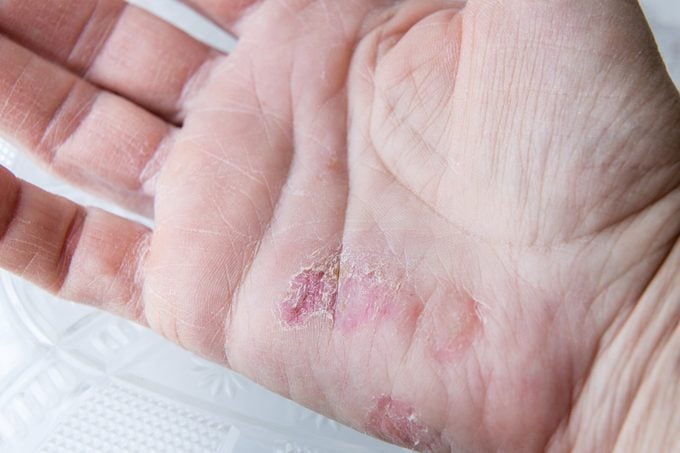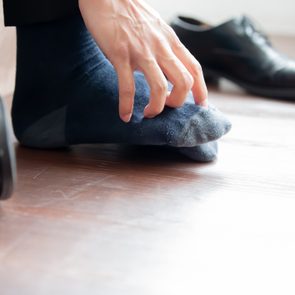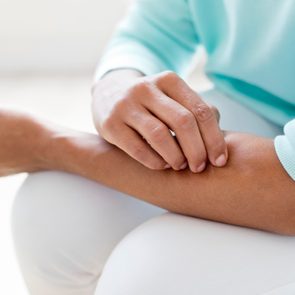18 Things You Should Know About Palmoplantar Psoriasis
Updated: Jul. 15, 2021
Palmoplantar psoriasis is a type of psoriasis on your palms and soles of your feet that can be especially difficult to treat. But there are ways to get this challenging condition under control.
Psoriasis on your feet and hands?
When you think of psoriasis, you probably imagine scaly patches on the knees, elbows, or arms. But this common skin condition can crop up almost anywhere on your body. And that includes the palms of your hands and soles of your feet.
Psoriasis affects more than eight million people in the United States, and between 12 percent and 16 percent of them will develop it on their feet and palms, according to the National Psoriasis Foundation.
When psoriasis develops on the palms of your hands, it’s usually called palmar psoriasis, and when it occurs on the soles of your feet, it’s called plantar psoriasis, explains Bruce Strober, MD, clinical professor of dermatology at Yale University and founder of Central Connecticut Dermatology Research in Cromwell, Connecticut.
Together, they make up a condition called palmoplantar psoriasis.
Understanding psoriasis
An inflammatory skin disease, psoriasis causes thick, reddened plaques. These plaques can itch and burn, and they may be covered with silvery scales.
Psoriasis occurs when your body’s immune system revs up its production of skin cells. Instead of shedding, these cells build up on your skin, forming the telltale plaques.
Psoriasis goes more than skin deep. The underlying inflammation is linked to an increased risk for heart disease, type 2 diabetes, and depression. Psoriasis can also take a toll on your quality of life, especially when it occurs on your hands and feet.
Your feet or hands may be covered in red, thick skin, and you may develop dry skin that cracks, itches, bleeds, and is covered with silvery scales.
Here’s everything else you need to know about palmoplantar psoriasis and how to best treat it and prevent it from coming back.

Palmoplantar psoriasis has a big impact
If psoriasis affects your hands, fingers, feet, or toes, it will have a dramatic effect on your quality of life.
That’s true despite the fact that you may have less body surface involved than people with psoriasis on other areas of the body, according to a study published in the Journal of the American Academy of Dermatology.
“These areas cause great difficulty due to the pain and embarrassment of this disease,” says Jashin Wu, MD, founder and CEO of the Dermatology Research and Education Foundation in San Diego. “There can be cracks and fissures in the skin that make it difficult to hold items or to walk.”
There’s also fear that people will think your psoriasis is contagious.
“I’ve had many palmoplantar psoriasis patients who are businessmen who are afraid to ‘close the deal’ since they can’t shake a hand,” Dr. Wu says.
Foot psoriasis can interfere with walking
When plaques develop on the soles of your feet, they can impair your ability to walk and move around, according to a study published in the Journal of the American Academy of Dermatology.
In fact, people with foot psoriasis are almost twice as likely to report problems with mobility and almost 2.5 times more likely to say they experienced difficulty completing daily activities, compared with those who had moderate to severe plaque psoriasis.
Get a diagnosis
It may mimic other skin diseases
Hand psoriasis may look like hand eczema, and foot psoriasis sometimes resembles athlete’s foot.
It’s important to see a dermatologist to make sure you have the right diagnosis, as treatments may differ, says Michele S. Green, MD, a dermatologist at Lenox Hill Hospital in New York City.
Symptoms and side effects
You may develop sausage-like fingers and toes
The medical name for these swollen digits is dactylitis, and it can be really painful. It mainly occurs with psoriatic arthritis, which palmoplantar psoriasis puts you at a higher risk for.
Your nails will likely be affected too
If your hands and feet are involved, there’s a good chance your nails are, too, says Dr. Strober, who is also the editor in chief of the Journal of Psoriasis and Psoriatic Arthritis.
Nail psoriasis symptoms include white, brown, or yellow nails, pitting in the nails, and crumbling.
You could get painful swelling
Enthesitis is a painful swelling in the connective tissue that attaches your ligaments and tendons to bone. It often strikes the sole of the foot and the back of your heel, among other spots.
Like dactylitis, enthesitis also tends to occur with psoriatic arthritis. And palmoplantar psoriasis raises your risk for that condition.
You might develop blisters
A side effect of psoriasis on your palms and the bottom of your feet: blisters.
You might hear this called palmoplantar pustular psoriasis or pustulosis. It’s a relatively rare condition that’s marked by small, pus-filled blisters on affected areas. In this case, you’ll notice them on your feet and hands.
These blisters can also cause painful cracks.
It increases your risk for psoriatic arthritis
About 30 percent of people with psoriasis will develop psoriatic arthritis, which can cause inflammation and pain in the joints.
Your psoriatic arthritis risk is greater if you have psoriasis on your hands and feet, according to the New Zealand Dermatological Society.
Treatment
Managing palmoplantar psoriasis is tricky
It’s not always easy to treat psoriasis when it occurs on your palms and the soles of your feet.
“The thick skin on the soles and palms acts as a barrier to the effective penetration of topicals,” says Dr. Khattri.
In other words, thanks to the thicker skin in those areas, it’s harder for creams to penetrate your skin. Which means they aren’t as effective.
Start with topical treatments
Doctors usually begin with topical treatments like steroid creams. These carry their fair share of risks, though. They can thin the skin, especially when used over the long term.
Your doctor may want to alternate between steroids and other topicals.
One option is calcipotriene, a form of vitamin D that slows down skin cell growth, says Saakshi Khattri, MD, assistant professor of dermatology, rheumatology, and internal medicine at Icahn School of Medicine at Mount Sinai Health System in New York City.
You may need to wear a sock or gloves over the treated area to make sure the medicine gets absorbed and not rubbed off. This is known as occlusion.
“You can’t occlude your hands during the day, though, since you need them to function,” Dr. Strober says. He recommends wearing cotton gloves over the topical at night.
You may need to bring out the big guns
Treating palmoplantar psoriasis can be difficult. “Most will have already failed a topical steroid when they see me,” says Dr. Wu.
He tends to prescribe oral treatments such as methotrexate, apremilast, cyclosporine, and acitretin. These drugs all work in different ways to tweak the immune system and/or cool inflammation.
Biologics are next up to bat, Dr. Khattri says. These drugs target specific proteins in the immune system that play a role in inciting the inflammation cascade.
“If [your psoriasis] is extensive or involvement is part of generalized psoriasis, making it overall moderate to severe in regards to body surface area involvement, biologics can be considered from the start,” she says.
There’s a role for UV-based light therapy
Ultraviolet light, or UV light therapy, may help treat psoriasis on your hands and feet.
This involves the use of ultraviolet B (UVB) light—either broadband or narrow band—or a combination of psoralen (a light-sensitizing topical) plus ultraviolet A (UVA) light to slow the growth of affected skin cells.
These phototherapy treatments may be done in the office or at home.
Prevention
Taking steps to avoid flares
Avoid triggers such as stress, injury to the skin, or illness where and when you can.
Find a healthy way to cope with stress, such as meditation, yoga, or even just taking a time-out and listening to music. Carve out relaxation time every single day.
Good skin care also makes a difference.
“It is important to moisturize these areas and avoid frequent hand washing,” Dr. Green says. Doing so can help relieve some of the symptoms of psoriasis such as dry skin, itching, and flaking.
This is the best skin care routine for psoriasis, according to top dermatologists.
Hand sanitizers may sting a lot
Using a hand sanitizer when plain old soap and water isn’t available has been an essential prevention strategy during the ongoing Covid-19 pandemic.
But if you have psoriasis on your hands, it can really sting, Dr. Wu says. You may want to avoid the sanitizer and opt for tried-and-true handwashing instead.
You shouldn’t wear high heels
Sorry, fashionistas. High heels can put too much pressure on your nails and joints, which can increase pain.
Look for shoes that minimize “trauma” and are comfy, Dr. Strober says. “Psoriasis relies on trauma in many patients, and you want to minimize that effect,” he says.
There’s no cure for psoriasis yet
Researchers are still working to find a cure for psoriasis, but today’s treatments are better than ever before. Psoriasis treatments can help a majority of people become clear or almost clear, Dr. Strober says.
Check in with your dermatologist to make sure you are doing all you can to relieve your symptoms and take your life back.
Next, find out the newest psoriasis treatments.

















